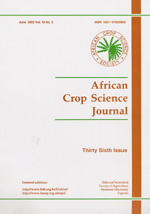
|
African Crop Science Journal
African Crop Science Society
ISSN: 1021-9730
EISSN: 1021-9730
Vol. 6, No. 4, 1998, pp. 417-421
|
 Bioline Code: cs98044
Bioline Code: cs98044
Full paper language: English
Document type: Short Communication
Document available free of charge
|
|
|
African Crop Science Journal, Vol. 6, No. 4, 1998, pp. 417-421
| fr |
Agona, J.A. & Nahdy, S.M.
Résumé
L'efficacité de solarisation sur
le contrôle de l'Acanthoscelides obtectus Say des
graines de haricot (Phaseolus vulgaris L.)
artificiellement infestées en séquence était
étudiée en utilisant un séchoir à bas
prix. L'effet de
traitement en chaleur sur la viabilité des semences et le
temps de cuisson étaient établis. Le temps de
solarisation variait pour 0, 1, 2, 3, 4, 5 et 6 heures, et les
temperatures minimales et maximales accomplies étaient
respectivement de 44 et 75.5 C . Les graines étaient
stockées à la température ambiante de la
chambre pour 3 mois. Le temps relatif de cuisson était
déterminé par la méthode de Mattson Drop Bar
pendant laquelle les haricots étaient à moitié
cuits. La viabilité des graines était
déterminée en plantant les haricots solarisés
et non solarisés dans le sable du lac. Il n'y avait pas d'émergence d'insecte adulte sur les haricots
exposés dans le séchoir solaire pour n'importe quelle durée à
partir d'une heure ou
plus d'exposition. Les
haricots non-traités étaient sévèrement
endommagés. La viabilité des graines était au
contraire affectée par la solarisation résultant
à 0 % d'émergence de haricots
traités pour 2 heures et plus, 35 % pour une heure d'exposition et 90 % dans les
contrôles. Le temps de cuisson le plus court était
atteint pour les graines non exposées à la
solarisation, et le temps le plus long était observé
avec les haricots exposés pour plus de 2 heures dans le
séchoir. La solarisation est recommandée pour les
haricots de consommation et non pour les semences dont la
durée d'exposition
ne devrait pas dépasser 2 heures dans le séchoir
solaire.
Mots Clés
Bruchidae, germination, Phaseolus vulgaris, solarisation
|
| |
| en |
Effect Of Solar Drying Period Of Beans On Seed Viability, Cooking Time And Injuriousness Of Acanthoscelides Obtectus Say
Agona, J.A. & Nahdy, S.M.
Abstract
The efficiency of solarisation using a low cost solar dryer,
on control of Acanthoscelides obtectus Say
(Coleoptera: Bruchidae) in sequentially artificially infested
beans (Phaseolus vulgaris L.) was investigated. The
effect of the heat treatment on seed viability and cooking time
were also examined. Solarisation periods varied for 0, 1, 2, 3, 4,
5 and 6 hours and the minimum and maximum temperatures achieved
were 44 and 75.5 C, respectively. The beans were then stored
under ambient room conditions for 3 months. Relative cooking time
was determined by the Mattson Drop Bar Method during which the
beans were cooked to the half-cooked point. Seed viability was
determined by planting the non- and solarised beans in moistened
lake sand. There was no single adult emergence on the beans when
exposed in the solar dryer for any duration beginning from 1 hour
and above. The non-treated beans were severely damaged. Seed
viability was adversely affected by solarisation resulting into 0%
emergence of beans treated for 2 hours and above; 35% for 1 hour
exposure and 90% in the controls. The shortest cooking time was
achieved in the non-solar exposed beans and the longest time was
observed on beans exposed for more than 2 hours in the dryer.
Solarisation is recommended for beans for consumption but not for
seed, and exposure should not be for more than 2 hours in the
dryer.
Keywords
Bruchidae, germination, Phaseolus vulgaris, solarisation
|
| |
© Copyright 1998 - African Crop Science Society
|
|
